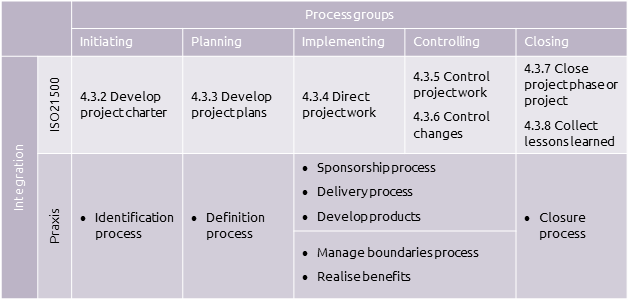Introduction
ISO21500 is a high level guide to project management, very similar in structure to the Project Management Institute’s (PMI®) Guide to the Project Management Body of Knowledge (PMBoK®).
It is important to note that ISO21500 is not a standard against which organisations can be accredited. It is purely a guide to good practice. The aim of this article is to demonstrate that all the good practice defined in ISO21500 is also covered by Praxis. Therefore, any organisation that implements Praxis can do so in a way that is ISO21500 compliant.
Inevitably, there are differences. Some key ones are described below:
-
ISO21500 is specific to project management, whereas Praxis also covers programmes and portfolios. An obvious consequence of this is that Praxis includes change management and benefits management. These are excluded from ISO21500.
-
Praxis is hierarchical whereas ISO21500 has a flat structure. This means that when describing equivalences, Praxis sometimes refers to top level functions, sometimes secondary level functions and sometimes steps in a functional procedure (the latter indicated by italics in the detailed comparisons).
-
Praxis adopts the ISO10006 approach to quality. As a result there is no separate section for quality management which is seen as being inherent in all other functions.
When comparing the two documents, sections 3.6, 3.9 and 4 of ISO21500 are the most relevant.
Section 3.6 addresses project governance and this is mainly addressed by the Praxis processes.
Section 3.9 makes reference to the competency groupings defined by the International Competency Baseline (ICB) published by the International Project Management Association (IPMA) although it does state that these are one example of how competencies can be categorised. In the Praxis competency framework, competencies are categorised as delivery, inter-personal and process.
Section 4 describes process groups and subject areas as shown in the table below. The subject area titles are annotated with the main equivalent Praxis functions or processes. The following sections describe these equivalences in more detail.
| Subject groups | Process groups | ||||
|---|---|---|---|---|---|
| Initiating | Planning | Implementing | Controlling | Closing | |
|
Integration (Life cycle processes) |
4.3.2 Develop project charter |
4.3.3 Develop project plans |
4.3.4 Direct project work |
4.3.5 Control project work 4.3.6 Control changes |
4.3.7 Close project phase or project 4.3.8 Collect lessons learned |
|
Stakeholder (Stakeholder management) |
4.3.9 Identify stakeholders |
4.3.10 Manage stakeholders |
|||
|
Scope (Scope management) |
4.3.11 Define scope 4.3.12 Create work breakdown structure 4.3.13 Define activities |
4.3.14 Control scope |
|||
|
Resource (Organisation management and resource management) |
4.3.15 Establish project team |
4.3.16 Estimate resources 4.3.17 Define project organisation |
4.3.18 Develop project team |
4.3.19 Control resources 4.3.20 Manage project team |
|
|
Time (Schedule management) |
4.3.21 Sequence activities 4.3.22 Estimate activity durations 4.3.23 Develop schedule |
4.3.24 Control schedule |
|||
|
Cost (Financial management) |
4.3.25 Estimate costs 4.3.26 Develop budget |
||||
|
Risk (Risk management) |
4.3.28 Identify risks 4.3.29 Assess risks |
4.3.30 Treat risks |
4.3.31 Control risks |
||
|
Quality (Inherent in all Praxis functions) |
4.3.32 Plan quality |
4.3.33 Perform quality assurance |
4.3.34 Perform quality control |
||
|
Procurement (Resource management) |
4.3.35 Plan procurements |
4.3.36 Select suppliers |
4.3.37 Administer procurements |
||
|
Communication (Stakeholder management and information management) |
4.3.38 Plan communications |
4.3.39 Distribute information |
4.3.40 Manage communications |
||
Integration
The integration subject group in ISO21500 is, in effect, a set of life cycle processes. Since pretty much all authorities agree on the basic phases of a life cycle, this is the common theme between not only ISO21500 and Praxis but also ISO21500 and PRINCE2, not to mention any other set of project or programme management processes.

-
Initiating:
The Project Charter is broadly similar in content to a brief in Praxis, as are the purposes of 4.3.2 Develop project charter and the goals of the identification process. These two processes are pretty much serving the same purpose in the same way -
Planning:
The outputs of 4.3.3 Develop project plans are the Project plan and the Project management plan. These equate to the delivery plans and management plans in Praxis, so the two processes are effectively the same. -
Implementing and Controlling:
The three ISO21500 processes collectively perform the same activities as the first three Praxis processes. There is no clear one-to-one correlation but collectively they do the same job.ISO21500 does not explicitly support the creation of stages within the delivery phase although it does recognise the creation of sub-projects and work packages. Therefore, there is no equivalent of the manage boundaries process and reduced versions of 4.3.3 Develop project plans and 4.3.7 Close project phase or project would be combined instead.
As with most guides to project management, ISO21500 deems that projects do not manage the realisation of benefits and so this aspect is omitted.
-
Closing:
The closing process and 4.3.7 Close project phase or project are the same in respect of closing a project. Aspects of 4.3.7 are included in Praxis’s manage boundaries process in respect of stages. - 4.3.8 Collect lessons learned is covered by the review activity in the closure process.





